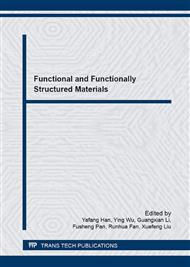p.228
p.233
p.237
p.243
p.249
p.256
p.262
p.272
p.279
Influence of Confinement on Ceramic’s Mechanical Properties
Abstract:
The wide use of ceramic material in engineering is restricted by its brittleness, so the strengthening and toughening of ceramics is always a hot spot of research in material area. And in general, the modification of ceramics is achieved by changing its internal microstructure. In this paper the influence of confinement on the mechanical properties of ceramics and the specific use of this method were investigated. Firstly, the influence of confinement on ceramic’s fracture process was analyzed in theory. Then the three-point bending test was conducted using two types of ceramics, viz. Zirconia and Alumina. The experimental results showed that the fracturing load of zirconia increased from 4.3298 to 5.4639KN as the confinement was increased from 0 to 150MPa, 26.19% increase was found in the confined specimen. The same trend was observed in alumina, whose fracturing load increased from 3.0446 to 5.0259KN as the confinement was increased from 0 to 150MPa, 65.07% increase was found. After that, a series of ballistic experiments were performed. The target in this experiment was boron carbide ceramic, and it was confined by 45 steel. The results showed that with the constraint force was bigger, the ballistic efficiency factor was better and the depth of penetration was smaller. In other words, the confinement can increase the defensible performance of the target. In summary, the ceramic’s fracture toughness, defensible performance and ballistic efficiency factor can be increased by adding confinement to it.
Info:
Periodical:
Pages:
249-255
Citation:
Online since:
March 2016
Authors:
Price:
Сopyright:
© 2016 Trans Tech Publications Ltd. All Rights Reserved
Share:
Citation:


